This Specimen has been sold.
3.9" Cobaltoan Dolomite Crystal Cluster - Kakanda, Congo
This is a cluster of vibrant pink cobaltoan dolomite crystals from the Kakanda deposit of the Democratic Republic of the Congo. Similar to cobaltoan calcite, cobaltoan dolomite gains its pink coloration from cobalt ions replacing magnesium and/or calcium within the crystal lattice.
Dolomite is an anhydrous carbonate mineral composed of calcium magnesium carbonate (CaMg(CO3)2).
The mineral dolomite crystallizes in the trigonal-rhombohedral system. It forms white, tan, gray, or pink crystals. Dolomite is a double carbonate, having an alternating structural arrangement of calcium and magnesium ions. It does not rapidly dissolve in dilute hydrochloric acid as calcite does. Crystal twinning is common.
Dolomite was first described by Carl Linnaeus in 1768, and in 1791 it was described as a rock by the French naturalist and geologist Déodat Gratet de Dolomieu. He first recognized the material in buildings of the old city of Rome, and later as samples collected in the mountains known as the Dolomite Alps of northern Italy.
The mineral dolomite crystallizes in the trigonal-rhombohedral system. It forms white, tan, gray, or pink crystals. Dolomite is a double carbonate, having an alternating structural arrangement of calcium and magnesium ions. It does not rapidly dissolve in dilute hydrochloric acid as calcite does. Crystal twinning is common.
Dolomite was first described by Carl Linnaeus in 1768, and in 1791 it was described as a rock by the French naturalist and geologist Déodat Gratet de Dolomieu. He first recognized the material in buildings of the old city of Rome, and later as samples collected in the mountains known as the Dolomite Alps of northern Italy.
SPECIES
Dolomite var. Cobaltoan Dolomite
LOCATION
Kakanda deposit, Kambove District, Lualaba, Democratic Republic of the Congo
SIZE
3.9 x 3.3"
CATEGORY
ITEM
#128378
 Reviews
Reviews













